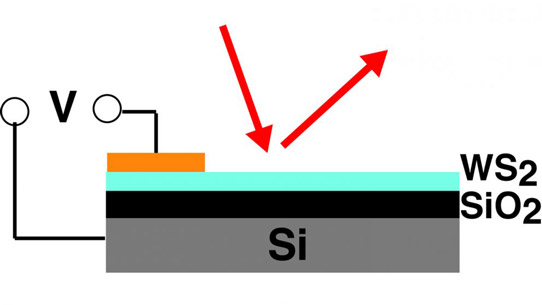- News
25 May 2017
Method developed for electrically tuning refractive index in metal dichalcogenide monolayers by 60%
North Carolina State University (NCSU) – in collaboration with researchers at Philadelphia’s Temple University and China’s Wuhan Institute of Technology – have discovered a technique for controlling light with electric fields (Yiling Yu et al, ‘Giant Gating Tunability of Optical Refractive Index in Transition Metal Dichalcogenide Monolayers’, Nano Letters; DOI: 10.1021/acs.nanolett.7b00768, 15 May).
“Light may be controlled to be strong or weak, spread or focused, pointing one direction or others by an electric field,” says Linyou Cao, assistant professor of materials science and engineering. “Just as computers have changed our way of thinking, this new technique will likely change our way of watching. For instance, it may shape a light into arbitrary patterns, which may find applications in goggle-free virtual reality lenses and projectors, the animation movie industry or camouflage.”
“Light may be controlled by tuning the refractive index of materials. The more one can control a material’s refractive index, the more control you have over the light that interacts with that material,” Cao says. “Unfortunately, it is very difficult to tune refractive index with electric fields,” he adds. “Previous techniques could only change the index for visible light by between 0.1 and 1% at the maximum.”
Cao and his collaborators have developed a technique that allows them to change the refractive index for visible light in some semiconductor materials by 60% – two orders of magnitude better than previous results. The researchers worked with a class of atomically thin transition metal dichalcogenide (TMDC) monolayers, specifically molybdenum sulfide (MoS2), tungsten sulfide (WS2) and tungsten selenide (WSe2).

Picture: Technique for electrically manipulating light through interaction with an atomically thin semiconductor.
“We changed the refractive index by applying charge to two-dimensional semiconductor materials in the same way one would apply charge to transistors in a computer chip,” Cao says. “Using this technique, we achieved significant, tunable changes in the index within the red range of the visible spectrum.”
Currently, the new technique allows researchers to tune the refractive index by any amount up to 60% – the greater the voltage applied to the material, the greater the degree of change in the index. And, because the researchers are using the same techniques found in existing computational transistor technologies, these changes are dynamic and can be made billions of times per second.
“This technique may provide capabilities to control the amplitude and phase of light pixel by pixel in a way as fast as modern computers,” says Yiling Yu, a recent graduate of NCSU and lead author of the paper.
“We can optimize the technique to achieve even larger changes in the refractive index,” believes Cao. “We also plan to explore whether this could work at other wavelengths in the visual spectrum.”
Cao and his team are also looking for industry partners to develop new applications for the discovery.
The work was undertaken with support from the US National Science Foundation (NSF) under grant ECCS-1508856, and from the Center for the Computational Design of Functional Layered Materials at Temple University, which is funded by the Department of Energy under grant DESC0012575.
NCSU transition-metal dichalcogenide
http://pubs.acs.org/doi/abs/10.1021/acs.nanolett.7b00768


